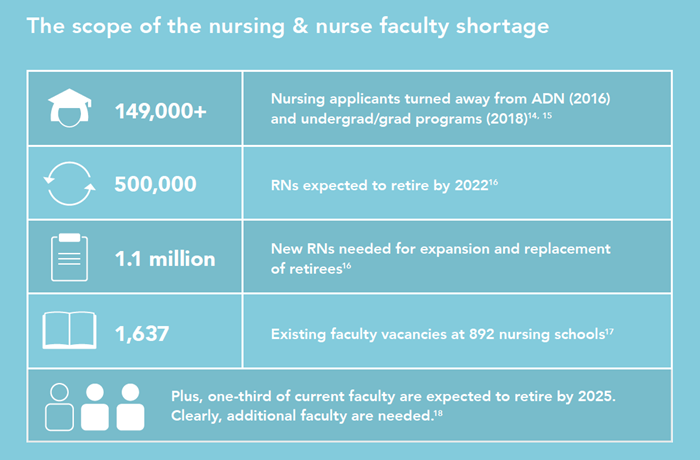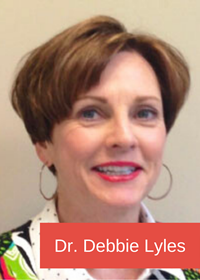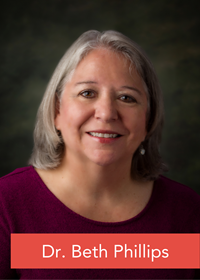Can your audacious steps help solve the nursing shortage?
One person can be the start of creating change for the nursing profession

It’s not news within nursing: The pandemic has intensified burnout causing many nurses and educators to leave the profession. Now, though, the world has started to take notice. National media sources — from NPR and USA Today to the New York Times — have repeatedly reported on the shortage of nurses and nurse educators.
The pandemic is expected to accelerate the number of nurses and nurse educators leaving the profession or retiring early. The result of this exodus will likely be more students turned away from nursing programs. Besides the lack of faculty to teach them is the lack of clinical sites, classroom space, clinical preceptors, and budget constraints.
Thus, the nursing shortage becomes even more concerning.
In 2010, the National Advisory Council on Nursing Education and Practice (NACNEP) published a report that spurred millions in investments from the Health Resources and Services Administration, other federal and state agencies, and philanthropic organizations. Unfortunately, their steps only minimally staunched the exodus.
 Newer recommendations are for the Department of Health and Human Services and Congress to take steps such as creating a national center for nursing education. While laudable, such proposals will likely take years, when time is truly of the essence.11
Newer recommendations are for the Department of Health and Human Services and Congress to take steps such as creating a national center for nursing education. While laudable, such proposals will likely take years, when time is truly of the essence.11
So, what can your program do now? NACNEP says we’ll need “bold, creative, collaborative, and targeted approaches.” To kick you off, we’ve identified actions you can begin today. (See "What you can do ... " below.)
ATI Director of Consulting Debbie Lyles, PhD, MN, RN, CNE, suggests, “As a profession, we must work closely with policy makers, nursing organizations, and the media to bring attention to this crisis. We must leverage our resources, identify strategies, and find creative and targeted approaches.”
What you can do: 5 ways to create more nurse educators
- Suggest academia as a career. Research by ATI’s Beth Phillips, PhD, RN, CNE, CHSE (see below in “Next steps”), backed up by a National Advisory Council on Nursing Education and Practice (NACNEP) report, shows students simply don’t think about becoming educators.6 Make a point to describe the professional satisfaction, rich relationships, and professional autonomy of being an educator.12, 13
- Channel students toward graduate programs. Offer electives such as those by Vanderbilt School of Nursing on “Curriculum strategies for health professional education” and “Online methodologies for nursing education.”
- Develop financial incentives. Walden University reduces tuition for future faculty by 10 percent. The University of Wisconsin offers fellowships and loan forgiveness, while Duke gives full scholarships to PhD students.11
- Support faculty tech expertise. The need for educators to be health-tech experts is only going to grow. To support this trend, the U.S. Department of Education lists specific competencies for nurse educators, such as using online tools to enhance teaching and learning, using appropriate technology tools for assessment, and offering professional development and networking to improve the tech integration into teaching. Encourage nurse educators to network and improve the integration and use of online tools for teaching, learning, and assessment.1, 16
- Spread the word about funding aid. To date, institutions have invested generously in growing the number of doctorally prepared nurses. Such largesse, however, isn’t expected to continue. While funding is still available, encourage students to apply ASAP. Suggest students look for opportunities with:
- the Faculty Loan Repayment Program (FLRP)
- the Nurse Corps
- the Nurse Faculty Loan Program (NFLP)
- the National Institute of Nursing Research (NINR)
- philanthropic organizations such as the Hillman Scholars Program in Nursing innovation and the Robert Wood Johnson Foundation
- the National League for Nursing’s Foundation for Nursing Education
- Partners Investing in Nursing’s Future (PIN)
- the Future of Nursing Scholars (FNS).
NEXT STEPS
- Read Dr. Beth Phillips’ article, “It is up to faculty: An exploration of RN-BSN students’ intent for faculty role,” in Nursing Education Perspectives (coming in September 2022).
- Request consulting support to address your program’s faculty shortages at atitesting.com/consulting-help.
Resources
1NGN Talks: A look at the strategic practice analysis & special research section video transcript. NCSBN.org. Published 2019. Accessed Nov. 3, 2021. https://ncsbn.org/Transcript_NGNTalk_Episode02.pdf.
6Research brief: Using RN Content Mastery Series test data to identify student needs. Atitesting.com. Published 2012. Accessed Nov. 3, 2021. www.atitesting.com/docs/defaultsource/research/research-brief---rn_cms_final.pdf?sfvrsn=35e006e9_0
11Preparing nurse faculty and addressing the shortage of nurse faculty and clinical preceptors 17th report to the Secretary of Health and Human Services and the U.S. Congress. National Advisory Council on Nurse Education and Practice. Dec. 2020. Accessed Nov. 3, 2021. www.hrsa.gov/sites/default/files/hrsa/advisory-committees/nursing/reports/nacnep-17report-2021.pdf.
12Aragon S, Ellis J. Survey of nursing educators in Washington State. Washington Center for Nursing. Dec. 2017. Accessed Nov. 3, 2021. https://www.
wcnursing.org/wp-content/uploads/documents/reports/2017-December-WCN-Survey-of-Nursing-Educators-in-Washington-State.pdf
13Van Riel Y, Gazza E, Phillips B. It is up to faculty: An exploration of RN-BSN students’ intent for faculty role. Nursing Ed Pers. Publication date pending.
14Phillips B, Simmons K. Competency-based curriculum and the AACN Essentials. Oral
presentation on: ATI Academy professional development course. 2021. Atitesting.com
15Employment of new nurse graduates and employer preferences for baccalaureate-prepared nurses. Accreditation Commission for Education in Nursing; Dec. 2020. Accessed Nov. 3, 2021. https://www.aacnnursing.org/Portals/42/News/Surveys-
Data/Research-Brief-12-20.pdf
16Workforce. Nursingworld.org. Accessed Nov. 3, 2021. https://www.nursingworld.org/practicepolicy/workforce
17Li Y, Turinetti M, Fang D. Special survey on vacant faculty positions for academic year 2018-2019. American Association of Colleges of Nursing. Oct. 2019. https://www.aacnnursing.org/Portals/42/News/Surveys-Data/Vacancy18.pdf
18Fang D, Kesten K. Retirements and succession of nursing faculty in 2016-2025. Nurs Outlook. Sept.-Oct. 2017;65(5):633-642. doi: 10.1016/j.outlook.2017.03.003
What is your program doing to alleviate the nursing shortage? Share in the comments below.
